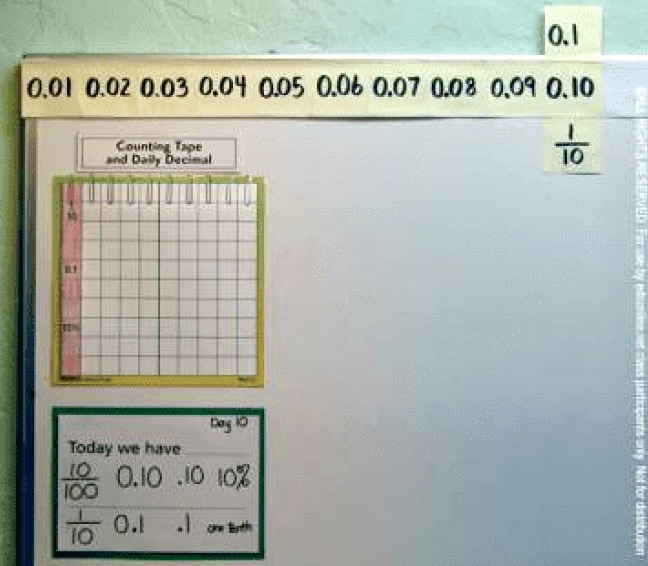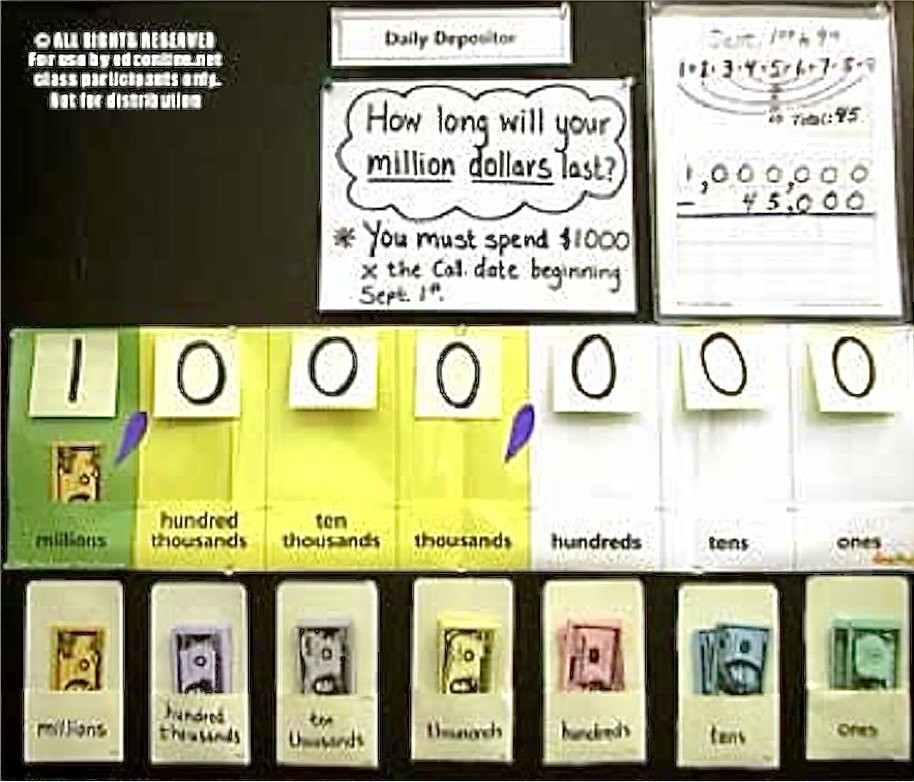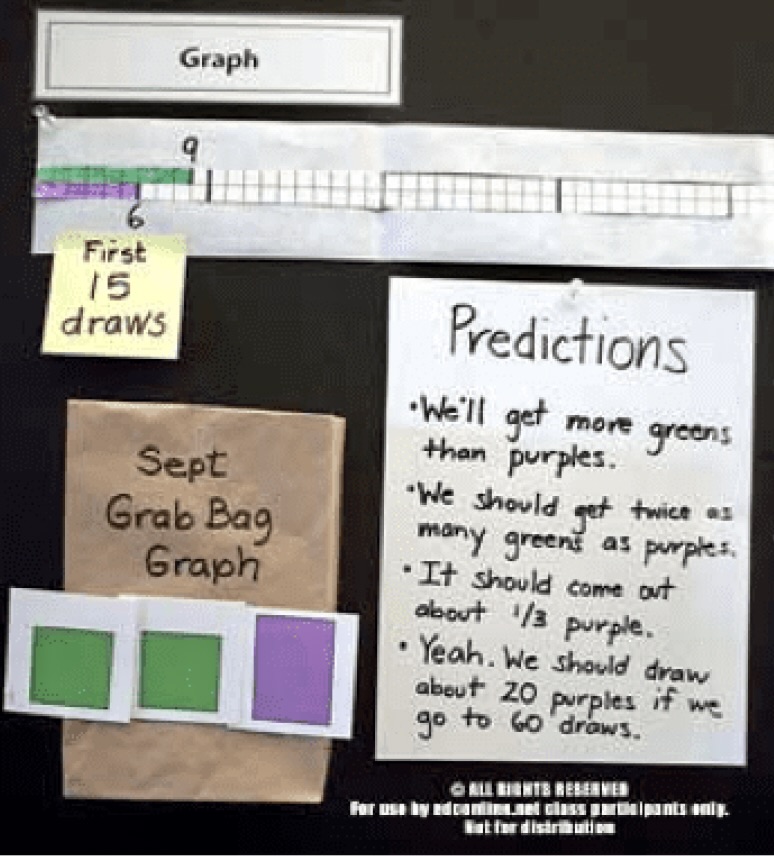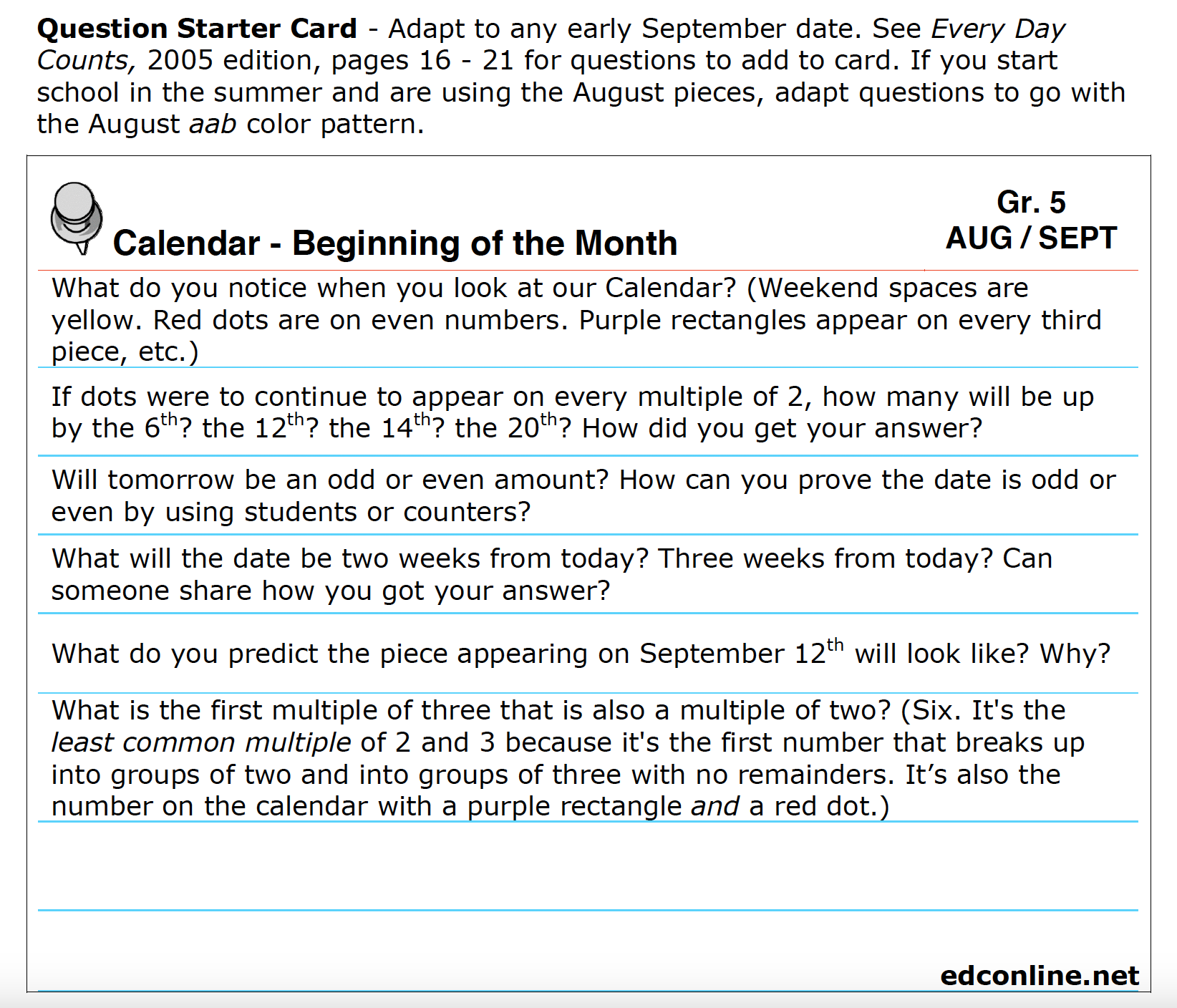Grade 5: EDC Counting Tape & Daily Decimal – Day of School


Instructor Notes:
For materials preparations, click again on Samples and select Getting Started 5.
Read Every Day Counts Teacher’s Guide, Kanter and Gillespie, Great Source, 2005 or 2012 edition, p. 25.
On the first day of the school year I like to engage students by asking “How much tape will we need to unroll to display 100 Post-its by the 100th Day of school, if we put up one Post-it each day we come to school?” Table groups problem solve, share strategies, and reach consensus on the length of tape required. I can learn much about my students during this first day of school activity. Then students help put up the 25 ft of tape and attach the first Post-It covering one hundredth of the distance to School Day 100, recording .01 or 0.01 on it. We also shade in one square in the upper left corner on the blank hundred chart and students generate several ways to record the shaded part as a fraction, decimal, and percent on the Today We Have Record. Each following school day we shade in one more hundredth of the grid and cover one more hundredth of the Tape.
Before the 10th day of school, have students use red crayons to shade in two sheets of the Tenths cardstock from the Teacher Resource Cardstock packet in Kit or print TR 4 Tenths on red copy paper. Cut them into tenth strips and use them to show equivalence between 0.10 and 0.1on Day 10.
Grade 5: EDC Daily Depositor – Day of School


Instructor Notes:
For materials preparations, click again on Samples and select Getting Started 5.
Read Every Day Counts Teacher’s Guide, Kanter and Gillespie, Great Source, 2005 or 2012 edition, p. 21-24.
Early September: Teachers have found many ways to kick off the fifth grade Depositor to engage students in spending down a million dollars at the rate of $1000 multiplied by the calendar date each day. Some read the book How Much Is a Million by D. Schwartz.
Begin on the first of the month, if school is in session. However, if your year begins after Labor Day in September, catch up by spending $1000 for Sept. 1st, $2000 for Sept 2nd, $3000 for Sept. 3rd, etc., until you reach the current date. In these photos, the Depositor is shown with money being spent for Sept. 1 through September 9th. (Adapt to Sept. 7th or 8th, if Sept 9th falls on a weekend.) The question becomes “How long will our million dollars last at this rate?”
Grade 5: EDC Calendar – Beginning of September or 1st Month of School


Instructor Notes:
For materials preparations, click again on Samples and select Getting Started 5.
Read Every Day Counts Teacher’s Guide, Kanter and Gillespie, Great Source, 2005 or 2012 edition, p. 16-21.
If you are on a year-round schedule or begin school in August, you may want to use the August calendar pieces for your first month of school. If your school year starts in September, use the September pieces. Both sets of pieces present an aab pattern of two square rectangles followed by one that is not square with an overlapping pattern of dots marking the even numbers.
To introduce the Calendar, display the calendar pieces up to the present date and ask students to share what they notice so far. You can use the green and purple rectangles to review the fact that rectangles include all four sided figures with four right angles, including squares. In the earlier grades in Every Day Counts, children refer to the square as a square rectangle to remind them that squares belong to the rectangle family because they have the rectangle’s defining attribute of 4 right angles.
Students will also notice the red dots marking the multiples of 2 and the purple rectangles marking the multiples of 3. To demonstrate the concept of common multiples of 2 and 3 you might have a number of students equal to the date stand on the 6th, 12th, 18th, etc, and group themselves into pairs and then into groups of three. This is a good month to review and test individuals on their x2 and x3 facts.
Grade 5: EDC Probability Graph – September

Instructor Notes:
For materials preparations, click again on Samples and select Getting Started 5.
Read Every Day Counts Teacher’s Guide, Kanter and Gillespie, Great Source, 2005 or 2012 edition, p. 28-31.
In September we can look at the Calendar’s aab color pattern on the 3rd, 6th, and 9th or any day that is a multiple of 3, and see that two thirds of the calendar pieces are green and one third are purple. Probability is no longer a grade 5 topic in the Common Core Standards, however the experiment, as described here, will be used to assess and support 5th graders’ developing fraction sense. It also engages them in reasoning and explaining their thinking when it comes to fractions.
By placing two green squares and one purple rectangle into a lunch sack and then drawing and replacing them a total of 60 times over the month, the class predicts the outcome based on the chances of drawing each color. Graphing the results of 15 draws at a time to show the cumulative results after 15, 30, 45, and 60 draws, develops fraction sense when students compare the resulting fractions for purple vs green pieces (e.g. 9/30 purple vs 21/30 green) against the expected result of 1/3 purple vs 2/3 green.
Students can also look to see if the fraction for each color can be simplified and compare any simplified fractions to 1/3 vs 2/3 (e.g 9/30 = 3/10 vs 21/30 = 7/10, How close is that to 1/3 vs 2/3?) What if we used percents to compare the results? (Above Gr 5 CCS standard)
Are there some surprises? As the sample increases will the results come closer to the probability of 2/3 purple and 1/3 green?





